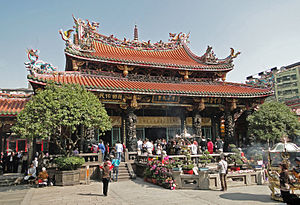
Religion in Taiwan is characterized by a diversity of religious beliefs and practices, due to its multicultural history, and religious freedom written in the constitution of the Republic of China. The original Native Taiwanese tribes traditionally practice nature worship. With the arrival of the Dutch in 1624, Protestant Christianity was introduced to Taiwanese via missionaries. The first converts were Indigenous Taiwanese. Two years later, with the arrival of the Spanish, Catholicism was introduced into Taiwan. The Japanese brought Shinto to Taiwan during the Japanese colonial period which began in 1895. Chinese migrants brought Buddhism and Taoism with them to the island over a few centuries of immigration and settlement. The Japanese persecuted “foreign” religions in Taiwan during their rule, which resulted in Islam disappearing until it was reintroduced by the Kuomintang.
The Bahá’í Faith in Taiwan began after the religion entered areas of China and nearby Japan. The first Bahá’ís arrived in Taiwan in 1949 and the first of these to have become a Bahá’í was Mr. Jerome Chu (Chu Yao-lung) in 1945 while visiting the United States. By May 1955 there were eighteen Bahá’ís in six localities across Taiwan. The first Local Spiritual Assembly in Taiwan was elected in Tainan in 1956. The National Spiritual Assembly was first elected in 1967 when there were local assemblies in Taipei, Tainan, Hualien, and Pingtung. Circa 2006 the Bahá’ís showed up in the national census with 16,000 members and 13 assemblies.
Buddhism, Taoism, and folk religion
Approximately 93% of people in Taiwan identify themselves as Buddhists, Taoists, or practitioners of Chinese folk religion. However, as with the majority of East Asian religious traditions in general, identification with these faiths does not necessarily mean actual affiliation as it does in many other parts of globe. It is also common for people to practice a blend of the three religions. Some people practice Buddhism exclusively, but most blend Taoist religious practices with elements from Buddhism and folk traditions. It is not uncommon to find a Buddhist temple adjacent to a Taoist temple, or even under the same roof. One example of this is Longshan Temple in Taipei City. Religious diversity has never been a significant source of conflict in Taiwan. Those who consider themselves “pure” Buddhists are usually allied with the Zhaijiao movement.
Another example of syncreticism commonly seen in religious life are the numerous sutra-chanting groups (誦經團) in Taiwan, which combine Buddhist, Taoist and folk religious spirituality, chanting, and ritual. In small rural areas where Buddhist and Taoist monastics are not readily available, trained sutra-chanting groups are hired by local villagers and townspeople to perform a variety of services, and are usually performed in the native Taiwanese Hokkien dialect rather than standard Mandarin. Chanting groups mainly consist of everyday men and women dressed in Buddhist monastic robes and playing traditional ritual instruments accompanied by an electronic keyboard.
Besides large temples, small outdoor shrines to local deities are very common, and can be spotted on roadsides, parks, and neighborhoods in Taiwanese cities and towns. These small pockets of religious atmosphere let people stop by and pray informally anytime. They also provide a safe environment for locals to practice meditation and various other forms of religious practice. Many homes and businesses may also set up small shrines of candles, figurines, and offerings. Some restaurants, for example, may set up a small shrine to the Kitchen god for success in a restaurant business. Students may visit a shrine to the Learning god for good luck before a test.
Taoist temples are highly decorative. Colorfully tiled sculptures of dragons and other mythological creatures highlight the roof, and temples are often filled with statues of many gods and semi-theistic historical figures, reflecting the polytheistic and ancestor worship tradition of Taoism and folk religion.
Festivities and picnics often take place at Taoist temples.
There are approximately 4.55 million[12] or 4.5 million Taoists in Taiwan and 4.9 million Buddhists.
Christianity
Christians which include Protestants, Catholics, Mormons, and non-denominational Christians make up a total of approximately 4.5% of the population of Taiwan.
Islam
Though Islam originated in the Arabian Peninsula, it had spread eastward to China as early as the 7th century AD. Muslim merchants married local Chinese women, creating a new Chinese ethnic group called the Hui people. Islam first reached Taiwan in the 17th century when Muslim families from the southern Chinese coastal province of Fujian accompanied Koxinga on his invasion to oust the Dutch from Taiwan. Islam did not spread and their descendants became assimilated into the local Taiwanese society adopting the local customs and religions.
During the Chinese Civil War, some 20,000 Muslims, mostly soldiers and civil servants, fled mainland China with the Kuomintang to Taiwan. Since the 1980s, thousands of Muslims from Myanmar and Thailand, who are descendants of Nationalist soldiers who fled Yunnan as a result of the communist takeover, have migrated to Taiwan in search of a better life. In more recent years, there has been a rise in Indonesian workers to Taiwan. There are an estimated 88,000 Indonesian Muslims living in Taiwan,[15] in addition to the existing 53,000 Taiwanese Muslims. All demographics combined, there are over 140,000 Muslims in Taiwan.
Falun Gong
Even though Falun Gong is banned in China, people in Taiwan are free to practice it.
Judaism
There has been a Jewish community in Taiwan since the 1950s. Since 2011, there has been a Chabad in Taipei.